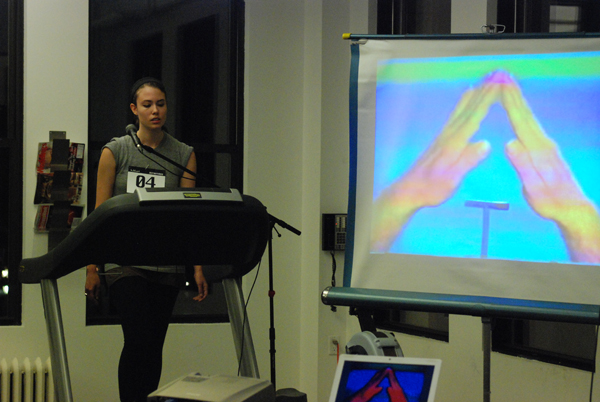-
Speed Reading at Definitions
by Alice Gregory November 16, 2009

For Brooklyn-based Cabinet Magazine’s contribution to Performa, the self-described “omnivorous” quarterly “interested in the margins of culture as its center” staged a 90-minute relay race. Three stories above Union Square, at a typically smelly, rubberized and fluorescent-lit Definitions Gym, regular Cabinet contributors and staff members, along with willing and able volunteers, read from a variety of self-chosen texts pertaining to the notion of speed. The catch? The readers were on moving treadmills, with the incline and speed personally calibrated – often to match the tone and content of the material.
Ambling on the central machine, Sina Najafi, Cabinet’s Editor-in-Chief, flanked on either side by matching treadmills, played the MC, or, as he preferred “Speed Demon,” summoning each reader from the audience by blowing a whistle. Hands in trouser pockets, strolling leisurely – indoors on a forever-repeating non-course – Najafi was a walking – ha! – parody of the flâneur. The gym, perhaps the paragon of a certain sort of urban renewal, and this one located only blocks from Greenwich Village, Jane Jacobs’s most frequently cited neighborhood, was a particularly loaded setting.

In keeping with Performa’s Futurist theme, though absent the slightest hint of violence, Cabinet took inspiration from Marinetti’s Manifesto in which speed, technology, ingenuity and youth were lauded as the pillars of the movement. Clad in diverse combinations of athletic wear and more formal suiting (outfits included a purple jumpsuit, a blazer/fedora combination and an absolutely typical jogging uniform), the readers were united together and distinguished from the lazier onlookers by numbered runners’ bids used to mark their order.
Selected texts, each to be read in under four minutes, included excerpts from early 19th-century news accounts of the newfangled velocipede; the Caucus-Race scene in Lewis Carroll’s Alice in Wonderland; Edgar Allan Poe’s hypnotic poem, The Bells; Einstein’s Theory of Relativity; documents from the Slow Sex Movement; a passage from an abandoned work by Samuel Beckett during which the reader increased his foot-speed when the author began to talk of running; and quotations from Freud’s essay On Transience about people for whom the passing of time is intolerable. Certain presenters were more affected than others. The exaggerated breathlessness of the reader of The Third Policeman, along with the slowly-walked, slowly-annunciated, and very short reading of an archival account of the Boston Molasses Disaster were two of the more thespian segments.
Perhaps the most effective, if also the most obvious, selection was Ted Berrigan’s Things To Do On Speed, read by a man in a blue wig and Julian Schnabel-esque yellow lens glasses: “…drink a quart of ice-cold pepsi/… Become a ravaged scarecrow/… Jump off a roof on the lower East Side/ or/ Write a 453 page unintelligible book/… Buy a Rolls Royce/… Consider anti-matter/… Discuss mother’s promiscuity/… In the Winter, switch to heroin, so you won’t catch pneumonia./ In the Spring, go back to speed.”

The last ten minutes were set to Kraftwerk’s concept album, Autobahn which seemed like an appropriate score for the DIY video playing on a screen aside the treadmills. Images included: hamsters scurrying in wheels, a FedEx commercial, clips from Speedy Gonzales, a cup stacking competition, clips form La Jette and Band of Outsiders, a sloth crossing a road, a Tai-Chi instructional video and champion completing a Rubik’s Cube in record time.
The event was broadly aligned with Nietzsche’s anti-nilhism (On Flaubert: “You can only read and write while sitting. That’s how I get you nihilist! The slowness is justly the sin against the Holy Spirit. Only what is thought in movement has value.”) What is thought in movement, however, is a far cry from what is read in movement, and this, quite patently, was the theatrical source of the event’s comedy. The project of reading such serious texts while exercising is one usually reserved for college freshman who quickly learn to stop trying to annotate Plato’s Republic while at the campus gym. Watching a kinetic reader is of course very different from watching a static reader, and apparently watching a kinetic reader is mutually exclusive with listening to a kinetic reader. You close your eyes and listen, or you open your eyes and watch.
Cabinet’s performance – delightful, funny, and totally exotic – was actually most successful in its absolute integrity of purpose. The event, in many ways, was the magazine itself in motion, for as Zizek says: “Cabinet’s mission is to breathe life back into non-academic intellectual life. Compared to it, every other magazine is a walking zombie.”

